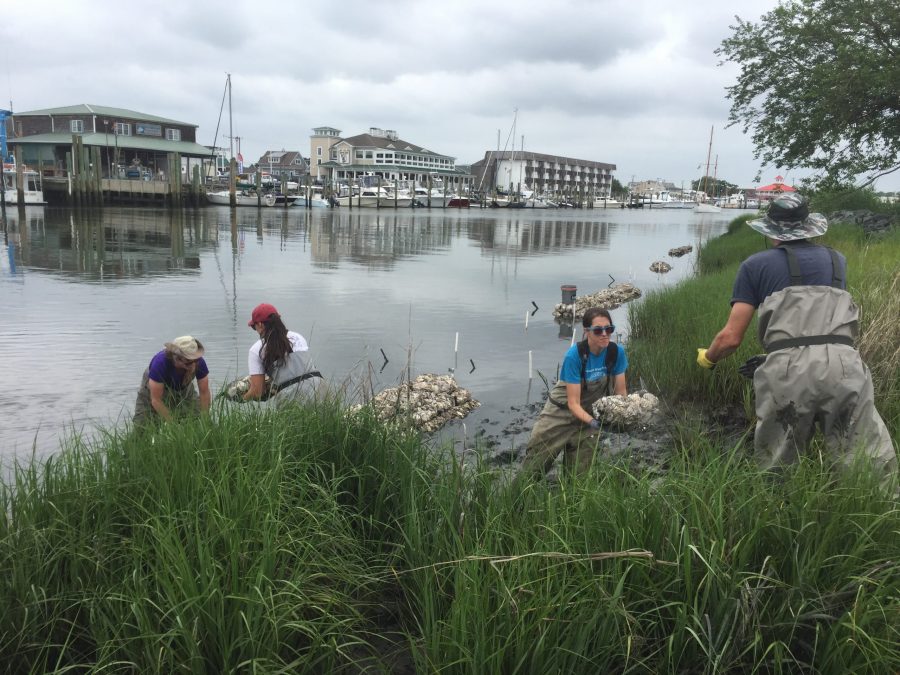Delaware Celebrates Lewes Canal Living Shoreline Project

A crew of 13 installed the living shoreline on the Lewes Canal in just one day in June. DNREC photo.
A living shoreline project developed by the Partnership for the Delaware Estuary to help Lewes, Delaware with shoreline stabilization was completed in partnership with Delaware Department of Natural Resources and Environmental Control, United States Fish and Wildlife Service, and the Delaware Living Shorelines Committee.
The Lewes Canal project was a joint effort to add a 180-foot feature adjacent to an already existing living shoreline constructed in 2014 behind the Lewes Little League ball field. A method of shoreline stabilization and protection for wetlands, living shorelines absorb storm energy and protect property while reducing the potential for shoreline erosion issues. They also filter pollutants to improve water quality, a notable benefit as Delaware recognizes National Water Quality Month in August.
“Living shorelines are an innovative and environmentally friendly alternative that uses natural materials such as oyster shells,” said DNREC Secretary Shawn M. Garvin. “This project is a good example of the benefits living shorelines provide: pollutant filtering to improve water quality; habitat for animals, fish and birds; and protection from erosion and of infrastructure; as well as aesthetics for property owners.”
The new portion was constructed using natural materials: a small amount of coconut fiber coir logs and 1,300 recycled oyster shell bags. A crew of 12 configured the oyster shell bags in long, wavy pyramid formations along the intertidal zone to reduce wave energy and allow wetland habitat restoration. The design includes breaks in the structure to allow tidal exchange, fish and fauna passage, and runoff outflow. This project will be monitored through a collaborative effort for several years to document increase of wetland size and populations of ribbed mussels and oysters.
“From fisheries and water quality to flood protection, the ecological health and resilience of the Delaware Estuary depends on our historically abundant coastal marshes, but sadly we are losing about an acre per day,” said Kathy Klein, executive director at the Partnership for the Delaware Estuary, which launched the Delaware Estuary Living Shoreline Initiative in 2008. “Thanks to its science-based design and monitoring, this project showcases how innovative, nature-based tactics can help stem these wetland losses.”
The project is a launching point for developing more partnerships and solutions to coastal restoration, as well as promoting green infrastructure efforts of the Delaware Living Shorelines Committee, a working group dedicated to facilitating the understanding, peer review and implementation of living shoreline tactics within the state. DNREC’s participation is represented by the Wetland Monitoring and Assessment Program.
Supporters of the project include the Partnership for the Delaware Estuary, United States Fish and Wildlife Service Delaware Bay Estuary Project, who provided funding through a small grant, and continued support from the Environmental Protection Agency. Property access and shoreline coordination provided by Lewes Historical Society and the Overfalls Foundation.
For more information, visit Delaware Living Shorelines at delawarelivingshorelines.org.
About DNREC The Delaware Department of Natural Resources and Environmental Control protects and manages the state’s natural resources, protects public health, provides outdoor recreational opportunities and educates Delawareans about the environment. The DNREC Division of Watershed Stewardship develops and implements innovative watershed assessment, monitoring and implementation activities. For more information, visit the website and connect with @DelawareDNREC on Facebook, Twitter or LinkedIn.
Media Contacts: Joanna Wilson, joanna.wilson@delaware.gov; Michael Globetti, michael.globetti@delaware.gov
